SEO
In-House vs Outsourcing Marketing: The Ins and Outs

Looking to expand your marketing capabilities? Then you should know what are the benefits and challenges of going in-house vs outsourcing marketing. Some companies have been working on moving their marketing teams in-house especially as the pandemic wears on, but others prefer to focus on their core functions and hire an external agency instead. The question is, what is right for you and your company?
What is in-house marketing?
In-house marketing is exactly what it sounds like—having a marketing team that is internal to the company. For example, here in SEO Hacker we have our own marketing team that is in charge of promoting the company, so we don’t have to hire an external agency to do the marketing for us.
According to The Drum, 57% of multinational companies have created in-house marketing departments, with an additional 17% considering building one. The pandemic has also accelerated the creation of these departments as companies want to be more cost-effective and practical, especially since companies are trying to be more frugal in their expenses.
Benefits of in-house vs outsourcing marketing
Companies would not be hurrying to build an in-house marketing team if there were no benefits. Here are some of them.
Potentially lower costs for the company
I’m going to be mentioning costs quite a bit in this article, and that’s really because the idea of lower or higher costs depends a lot on a number of factors. When looking at the benefits of in-house marketing, costs can be lower depending on two things: first is the skill set your team already has, and second is how willing you are to spend on building and managing a team of your own.
For example, if you have a small but strong marketing team right from the start, then that could be cost-effective. You can also opt to migrate some employees to a marketing role, but that is if the other teams can handle losing some team members. Then you also have to spend on training and resources for marketing.
If the total of those costs are lower than hiring an agency, then you can say that costs are lower with an in-house marketing team.
Stronger brand familiarity
Simple—your in-house marketing team is exposed to the day-to-day processes of your company, therefore they are more familiar with your brand. And since they are your employees, that means they also know your company philosophy and culture. You have the same (or at least, similar) work processes and they know the best approach for your company because they are embedded in the company.
Faster communication
There is no need to email or coordinate a meeting with an accounts manager because you literally can just walk over to their desks and they can walk over to yours. There is also less potential for miscommunication because the team already has an understanding of what the company wants.
For my company, we just use Slack to communicate with each other. Everyone is one message away.
More transparency and control
An in-house marketing team will be focused on your business only and considering how you already have a similar outlook and they have an in-depth understanding of your brand philosophy, then that translates to more control.
In terms of transparency, you get to really know how the marketing efforts are playing out as the team has more access to company data, therefore they have more transparent reports.
When you outsource marketing to another agency, they can only really give you the data that is showing up on their dashboards unless you will be providing them other numbers, such as your revenue.
Challenges of in-house vs outsourcing marketing
Just like there are benefits, there are also challenges to going in-house vs outsourcing marketing.
More work for the employees
First and foremost, especially if you have a limited budget for your marketing team, is that there is more work for your employees. Marketing is not a one-time or one-strategy thing; there are marketing plans to be made for different platforms, experiments, designs, executions, and monitoring.
For example, there is content marketing, email marketing, Pay-Per-Click, and SEO. These have different functions and need different strategies, and they have their own sets of skill sets that are integral to their success. For example, I update our SEO Hacker blog every Tuesday. I also have a podcast that has its dedicated team of producers, editors, and developers. My subscribers get updated every Monday through email. I also have my personal blog. Lastly, we have a retargeting and remarketing practice to ensure that our leads come back to our website.
So if you’re considering fully moving your marketing in-house, you need to look at the workload for those digital marketing strategies and figure out a way to balance them while ensuring your company is being cost-effective.
Limited skill set
With a limited budget comes a limited skill set. Unless you’re the kind of company owner who has no issues with overworking your team, then you won’t have the same skill set that outsourcing marketing to another agency will get you.
Lack of resources
Another challenge that your company could potentially have is the lack of resources, especially if you can’t afford multiple marketing experts and the tools that are needed for effective marketing.
Marketing is not as simple as creating a graphic and coming up with witty one-liners to catch your audience’s attention. It involves market research, keyword research, and a whole lot of strategizing. These strategies are based on data and not just solely on gut feeling. So if you have no way of getting data and monitoring your results, then effective marketing will be difficult to achieve.
Needing new employees
I sound like a broken record at this point, but marketing truly is an investment, and it’s one you shouldn’t skimp on. At some point, hiring and training new experts will be the investment you need to make. That said, going in-house vs outsourcing marketing can end up becoming more expensive for some companies as they end up hiring more people.
What is outsourced marketing?
Outsourced marketing is the exact opposite of in-house marketing. According to Hinge, outsourced marketing is the practice of partnering with an external agency for the company’s marketing needs.
Benefits of outsourced marketing vs in-house
Just as there are benefits to having an in-house team, there are also benefits to hiring an agency.
Companies can focus their resources on core functions
If you aren’t a marketing agency—let’s say, you’re in the construction business—and you’re thinking of having an in-house marketing team, that means you will have to budget your resources on functions that are outside of your business.
When you outsource your marketing, especially if you find a good partner, you get to just focus on whatever your company really does as the marketing portion can be entrusted to someone else.
That is also why in finding an agency, it’s integral that you know how to find a good one.
Access to a specialized team
One of the best things about outsourcing your marketing instead of building one in-house is that you get access to a team of experts at potentially a fraction of the cost. As I mentioned earlier, marketing isn’t a one-time thing. And it certainly isn’t a one-person endeavor.
Hiring an agency means you get writers, developers, designers, and researchers—basically, an entire team of people who live and breathe marketing—to do the work for you while you focus on other things. For example, here’s our team.
More resources for lower costs
Like I said earlier, I will be mentioning costs a couple of times in this post. As you get an entire team when you hire an agency, you also get their resources to be used for your benefit.
Now, some will say that hiring an agency is expensive. It really depends on how you see it and if you do have a workable budget. For example, our SEO services package costs $2,500 to $5,500 per month, with a 12 months lock-in. Yes, that is expensive, but take a look at what’s in the package:
- Site analysis
- Keyword research
- Blog setup
- Quality SEO copywriting
- Link building
- On-page optimization
- Paid directory listing
- Google Analytics reports
- Guest posting
- Monthly reports
And those are just the headers. For example, check out the “Quality SEO copywriting header.”

Here is the “On-page optimization” header:

As you can see, they involve a lot of work, and they involve their own tools and resources to be done right as well. So, yes, it seems expensive, but that’s because there’s an entire team composed of people with various specialties that is working for you.
Imagine if you have to hire people to do all these things, especially if the core function of your business is far from marketing.
Reduced risks
When you outsource marketing to a reputable agency, you ensure that your marketing is taken care of well. The team they assign to you will work hard to ensure that you aren’t wasting the money you’re spending on them on risky endeavors because everything is well-researched. And in the event that they will need to do some experimentation, the results of those experiments are well-documented so they know what’s working and what isn’t.
Challenges of outsourcing marketing vs in-house
There are a couple of challenges that need to be considered when outsourcing marketing vs going in-house.
Communication can potentially be tricky
In this case, the marketing team won’t be a desk or a chat away. They’re completely in a different company, so meetings will definitely need to be scheduled and coordinated. The agency can try to offset this challenge by assigning an accounts manager to your company whom you can contact whenever you have concerns.
Sometimes miscommunication can still happen, but that is why it’s incredibly important to be open and to just overcommunicate instead of expecting that both parties already understand the expectations and concerns of the partner.
Difference in company values
Another challenge that a company can have is looking for an agency that has similar values as they do. You wouldn’t want to end up hiring a company that believes in employing shady tactics or doesn’t believe in transparency.
That’s why when looking for an agency, make sure you check what their current and previous clients have to say about them. Do they take unnecessary risks? Were they difficult to communicate with? Do they see their clients as mere clients, or as partners? It’s important that you and your agency are a good fit for each other so that you can work together smoothly.
It can be expensive if you don’t have the budget
Again, we go back to budget concerns. As I mentioned earlier, outsourcing marketing can be a bit expensive, but that’s because there is plenty of work that comes with marketing. If you don’t have the budget, you can opt to go in-house and start your marketing on a smaller scale.
One thing that some companies do is to work on a hybrid setup. For example, a full digital marketing package from SEO Hacker costs around $3,500 to $9,900. Some of our partners decide to go with our SEO package, or even our email sales automation package which costs around $1,000 to $3,000. They outsource that work to us and work on their own marketing which they have a team for, and we coordinate our efforts to make sure we’re aligned.
For companies that don’t exactly have the budget for a full outsourcing or a full in-house team, a hybrid setup is the perfect solution.
For example, here are our clients, and plenty of them have a hybrid setup with us:

Less access to the team
Unlike if you have an in-house marketing team, you only really get to communicate with the accounts manager assigned to you when you decide to outsource your marketing. In an in-house setup, you get to speak with everybody, but that isn’t possible with an agency unless you specifically request to do so.
Key takeaway
So, should you go for in-house vs outsourcing marketing to another agency? The question here is, as always, what does your company need? And can you afford it?
Whether you build your team in-house or outsource your marketing, there will be a set of benefits and challenges. It could be too expensive, or new employees could be difficult to train. There could be more risks involved or a potential for miscommunication. Or you could find that either one is more cost-effective and practical for you in the long run.
And for those who don’t have the resources to go fully in-house or outsourced, a hybrid setup can be the way to go. It’s the best of both worlds for some, although it could have its own challenges such as coordination and alignment. But at least, that option is available.
Do you think going in-house vs outsourcing marketing is the way to go? Or is it vice-versa, or even both? Let me know in the comments what you think!
Source link
SEO
56 Google Search Statistics to Bookmark for 2024

If you’re curious about the state of Google search in 2024, look no further.
Each year we pick, vet, and categorize a list of up-to-date statistics to give you insights from trusted sources on Google search trends.
Check out more resources on how Google works:




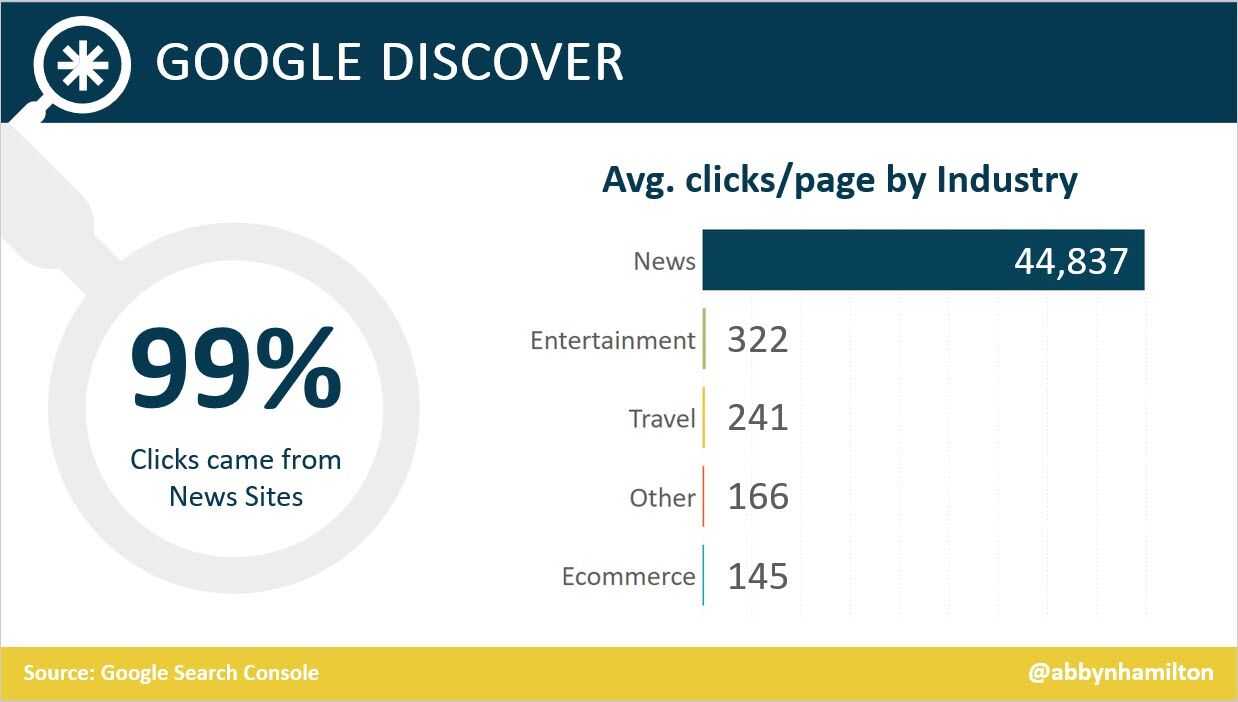



Learn more
SEO
How To Use ChatGPT For Keyword Research

Anyone not using ChatGPT for keyword research is missing a trick.
You can save time and understand an entire topic in seconds instead of hours.
In this article, I outline my most effective ChatGPT prompts for keyword research and teach you how I put them together so that you, too, can take, edit, and enhance them even further.
But before we jump into the prompts, I want to emphasize that you shouldn’t replace keyword research tools or disregard traditional keyword research methods.
ChatGPT can make mistakes. It can even create new keywords if you give it the right prompt. For example, I asked it to provide me with a unique keyword for the topic “SEO” that had never been searched before.
“Interstellar Internet SEO: Optimizing content for the theoretical concept of an interstellar internet, considering the challenges of space-time and interplanetary communication delays.”
Although I want to jump into my LinkedIn profile and update my title to “Interstellar Internet SEO Consultant,” unfortunately, no one has searched that (and they probably never will)!
You must not blindly rely on the data you get back from ChatGPT.
What you can rely on ChatGPT for is the topic ideation stage of keyword research and inspiration.
ChatGPT is a large language model trained with massive amounts of data to accurately predict what word will come next in a sentence. However, it does not know how to do keyword research yet.
Instead, think of ChatGPT as having an expert on any topic armed with the information if you ask it the right question.
In this guide, that is exactly what I aim to teach you how to do – the most essential prompts you need to know when performing topical keyword research.
Best ChatGPT Keyword Research Prompts
The following ChatGPT keyword research prompts can be used on any niche, even a topic to which you are brand new.
For this demonstration, let’s use the topic of “SEO” to demonstrate these prompts.
Generating Keyword Ideas Based On A Topic
What Are The {X} Most Popular Sub-topics Related To {Topic}?
The first prompt is to give you an idea of the niche.
As shown above, ChatGPT did a great job understanding and breaking down SEO into three pillars: on-page, off-page & technical.
The key to the following prompt is to take one of the topics ChatGPT has given and query the sub-topics.
What Are The {X} Most Popular Sub-topics Related To {Sub-topic}?
For this example, let’s query, “What are the most popular sub-topics related to keyword research?”
Having done keyword research for over 10 years, I would expect it to output information related to keyword research metrics, the types of keywords, and intent.
Let’s see.
 Screenshot from ChatGPT 4, April 2024
Screenshot from ChatGPT 4, April 2024Again, right on the money.
To get the keywords you want without having ChatGPT describe each answer, use the prompt “list without description.”
Here is an example of that.
List Without Description The Top {X} Most Popular Keywords For The Topic Of {X}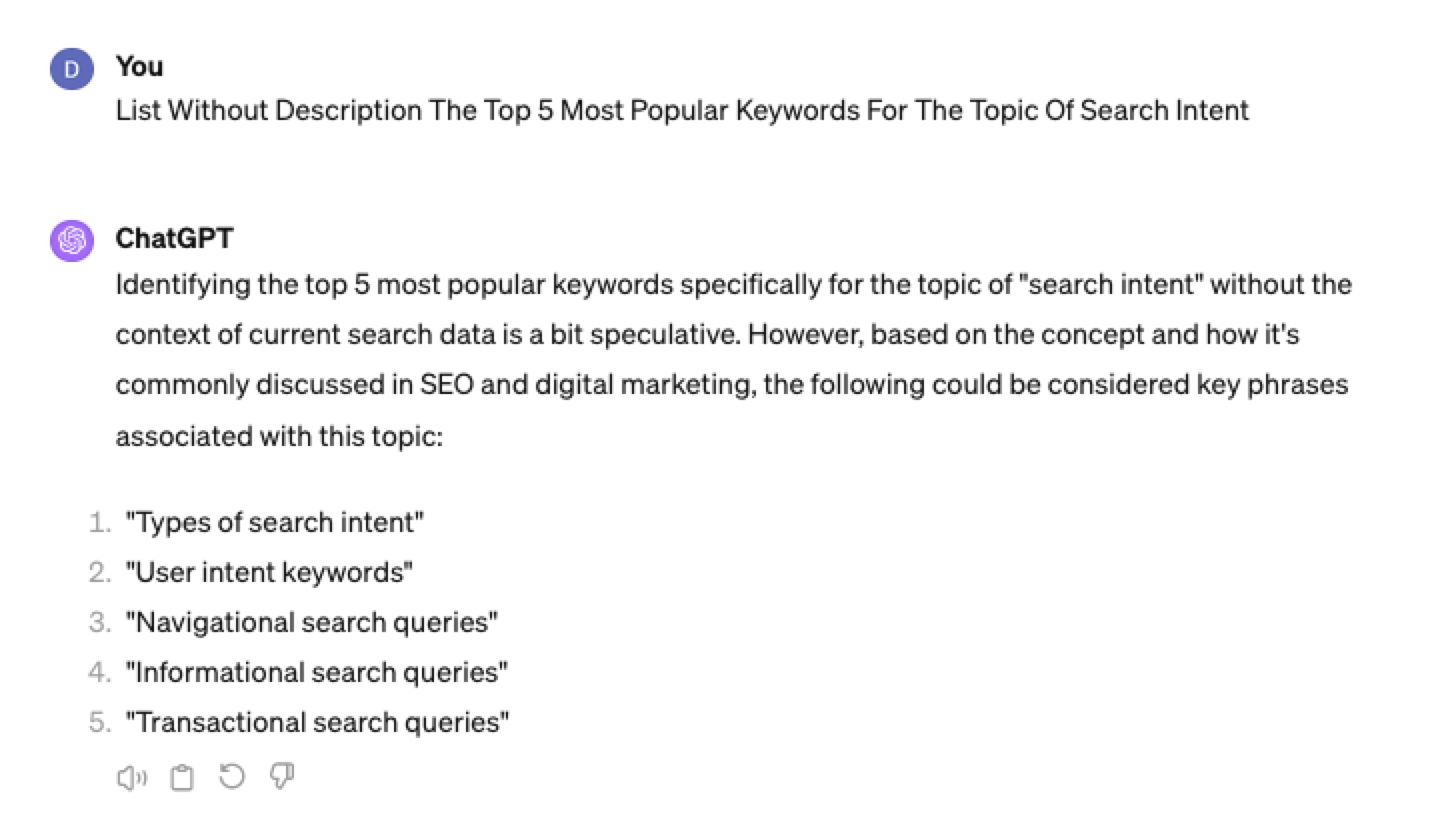
You can even branch these keywords out further into their long-tail.
Example prompt:
List Without Description The Top {X} Most Popular Long-tail Keywords For The Topic “{X}”
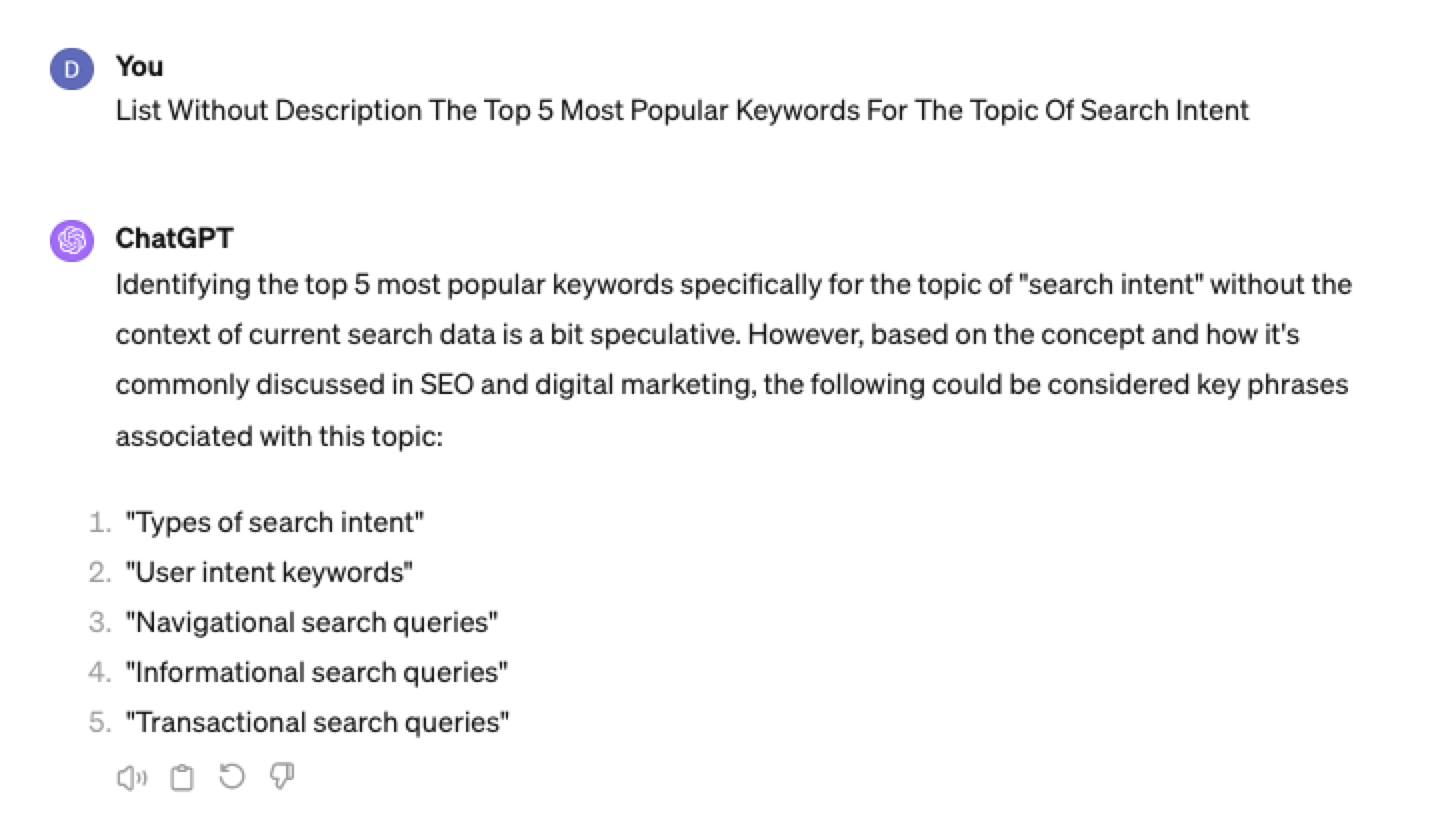 Screenshot ChatGPT 4,April 2024
Screenshot ChatGPT 4,April 2024List Without Description The Top Semantically Related Keywords And Entities For The Topic {X}
You can even ask ChatGPT what any topic’s semantically related keywords and entities are!
 Screenshot ChatGPT 4, April 2024
Screenshot ChatGPT 4, April 2024Tip: The Onion Method Of Prompting ChatGPT
When you are happy with a series of prompts, add them all to one prompt. For example, so far in this article, we have asked ChatGPT the following:
- What are the four most popular sub-topics related to SEO?
- What are the four most popular sub-topics related to keyword research
- List without description the top five most popular keywords for “keyword intent”?
- List without description the top five most popular long-tail keywords for the topic “keyword intent types”?
- List without description the top semantically related keywords and entities for the topic “types of keyword intent in SEO.”
Combine all five into one prompt by telling ChatGPT to perform a series of steps. Example:
“Perform the following steps in a consecutive order Step 1, Step 2, Step 3, Step 4, and Step 5”
Example:
“Perform the following steps in a consecutive order Step 1, Step 2, Step 3, Step 4 and Step 5. Step 1 – Generate an answer for the 3 most popular sub-topics related to {Topic}?. Step 2 – Generate 3 of the most popular sub-topics related to each answer. Step 3 – Take those answers and list without description their top 3 most popular keywords. Step 4 – For the answers given of their most popular keywords, provide 3 long-tail keywords. Step 5 – for each long-tail keyword offered in the response, a list without descriptions 3 of their top semantically related keywords and entities.”
Generating Keyword Ideas Based On A Question
Taking the steps approach from above, we can get ChatGPT to help streamline getting keyword ideas based on a question. For example, let’s ask, “What is SEO?”
“Perform the following steps in a consecutive order Step 1, Step 2, Step 3, and Step 4. Step 1 Generate 10 questions about “{Question}”?. Step 2 – Generate 5 more questions about “{Question}” that do not repeat the above. Step 3 – Generate 5 more questions about “{Question}” that do not repeat the above. Step 4 – Based on the above Steps 1,2,3 suggest a final list of questions avoiding duplicates or semantically similar questions.”
 Screenshot ChatGPT 4, April 2024
Screenshot ChatGPT 4, April 2024Generating Keyword Ideas Using ChatGPT Based On The Alphabet Soup Method
One of my favorite methods, manually, without even using a keyword research tool, is to generate keyword research ideas from Google autocomplete, going from A to Z.
-
 Screenshot from Google autocomplete, April 2024
Screenshot from Google autocomplete, April 2024
You can also do this using ChatGPT.
Example prompt:
“give me popular keywords that includes the keyword “SEO”, and the next letter of the word starts with a”
 Screenshot from ChatGPT 4, April 2024
Screenshot from ChatGPT 4, April 2024Tip: Using the onion prompting method above, we can combine all this in one prompt.
“Give me five popular keywords that include “SEO” in the word, and the following letter starts with a. Once the answer has been done, move on to giving five more popular keywords that include “SEO” for each letter of the alphabet b to z.”
Generating Keyword Ideas Based On User Personas
When it comes to keyword research, understanding user personas is essential for understanding your target audience and keeping your keyword research focused and targeted. ChatGPT may help you get an initial understanding of customer personas.
Example prompt:
“For the topic of “{Topic}” list 10 keywords each for the different types of user personas”
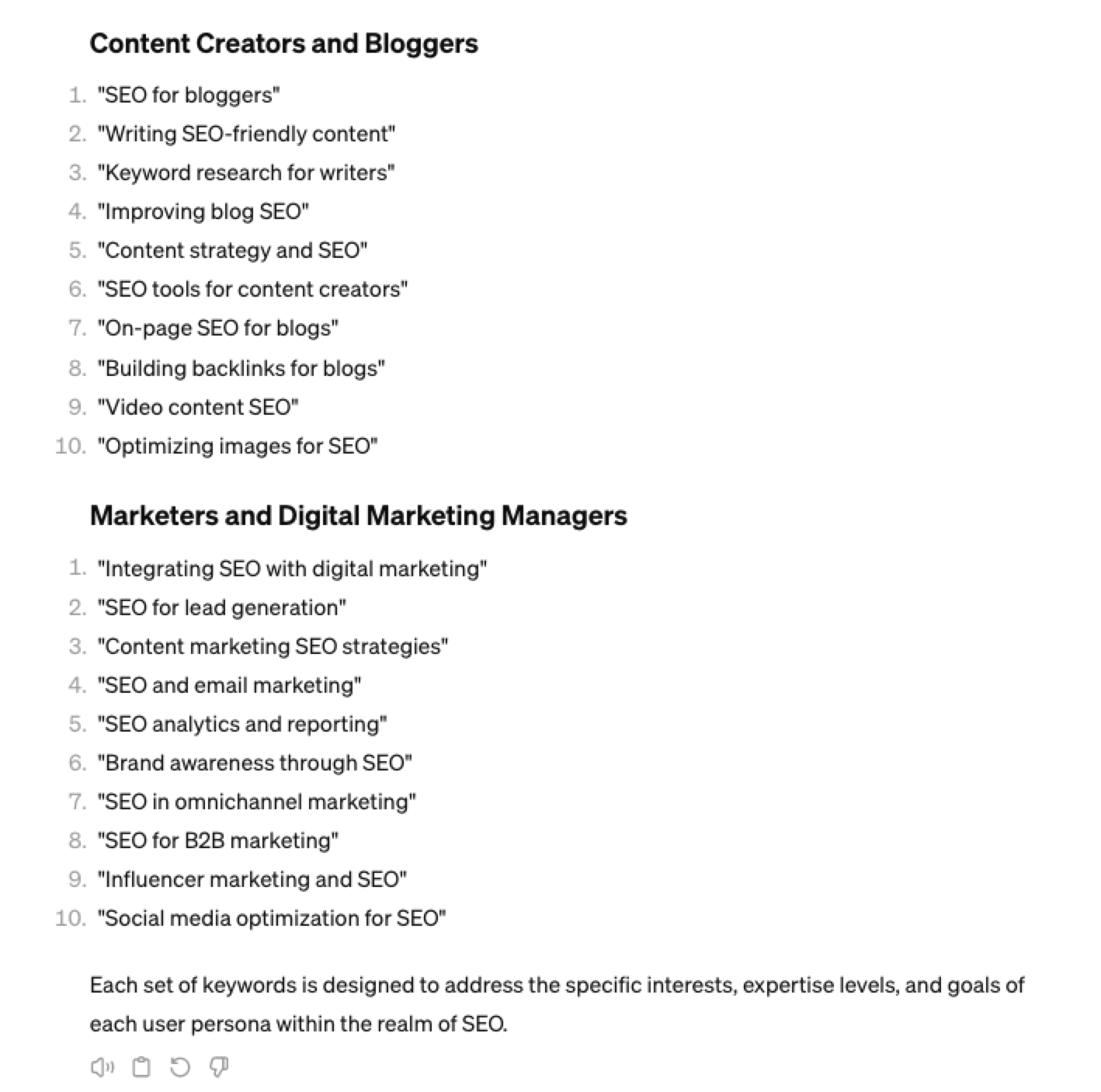 Screenshot from ChatGPT 4, April 2024
Screenshot from ChatGPT 4, April 2024You could even go a step further and ask for questions based on those topics that those specific user personas may be searching for:
 Screenshot ChatGPT 4, April 2024
Screenshot ChatGPT 4, April 2024As well as get the keywords to target based on those questions:
“For each question listed above for each persona, list the keywords, as well as the long-tail keywords to target, and put them in a table”
 Screenshot from ChatGPT 4, April 2024
Screenshot from ChatGPT 4, April 2024Generating Keyword Ideas Using ChatGPT Based On Searcher Intent And User Personas
Understanding the keywords your target persona may be searching is the first step to effective keyword research. The next step is to understand the search intent behind those keywords and which content format may work best.
For example, a business owner who is new to SEO or has just heard about it may be searching for “what is SEO.”
However, if they are further down the funnel and in the navigational stage, they may search for “top SEO firms.”
You can query ChatGPT to inspire you here based on any topic and your target user persona.
SEO Example:
“For the topic of “{Topic}” list 10 keywords each for the different types of searcher intent that a {Target Persona} would be searching for”
ChatGPT For Keyword Research Admin
Here is how you can best use ChatGPT for keyword research admin tasks.
Using ChatGPT As A Keyword Categorization Tool
One of the use cases for using ChatGPT is for keyword categorization.
In the past, I would have had to devise spreadsheet formulas to categorize keywords or even spend hours filtering and manually categorizing keywords.
ChatGPT can be a great companion for running a short version of this for you.
Let’s say you have done keyword research in a keyword research tool, have a list of keywords, and want to categorize them.
You could use the following prompt:
“Filter the below list of keywords into categories, target persona, searcher intent, search volume and add information to a six-column table: List of keywords – [LIST OF KEYWORDS], Keyword Search Volume [SEARCH VOLUMES] and Keyword Difficulties [KEYWORD DIFFICUTIES].”
-
 Screenshot from ChatGPT, April 2024
Screenshot from ChatGPT, April 2024
Tip: Add keyword metrics from the keyword research tools, as using the search volumes that a ChatGPT prompt may give you will be wildly inaccurate at best.
Using ChatGPT For Keyword Clustering
Another of ChatGPT’s use cases for keyword research is to help you cluster. Many keywords have the same intent, and by grouping related keywords, you may find that one piece of content can often target multiple keywords at once.
However, be careful not to rely only on LLM data for clustering. What ChatGPT may cluster as a similar keyword, the SERP or the user may not agree with. But it is a good starting point.
The big downside of using ChatGPT for keyword clustering is actually the amount of keyword data you can cluster based on the memory limits.
So, you may find a keyword clustering tool or script that is better for large keyword clustering tasks. But for small amounts of keywords, ChatGPT is actually quite good.
A great use small keyword clustering use case using ChatGPT is for grouping People Also Ask (PAA) questions.
Use the following prompt to group keywords based on their semantic relationships. For example:
“Organize the following keywords into groups based on their semantic relationships, and give a short name to each group: [LIST OF PAA], create a two-column table where each keyword sits on its own row.
-
 Screenshot from ChatGPT, April 2024
Screenshot from ChatGPT, April 2024
Using Chat GPT For Keyword Expansion By Patterns
One of my favorite methods of doing keyword research is pattern spotting.
Most seed keywords have a variable that can expand your target keywords.
Here are a few examples of patterns:
1. Question Patterns
(who, what, where, why, how, are, can, do, does, will)
“Generate [X] keywords for the topic “[Topic]” that contain any or all of the following “who, what, where, why, how, are, can, do, does, will”
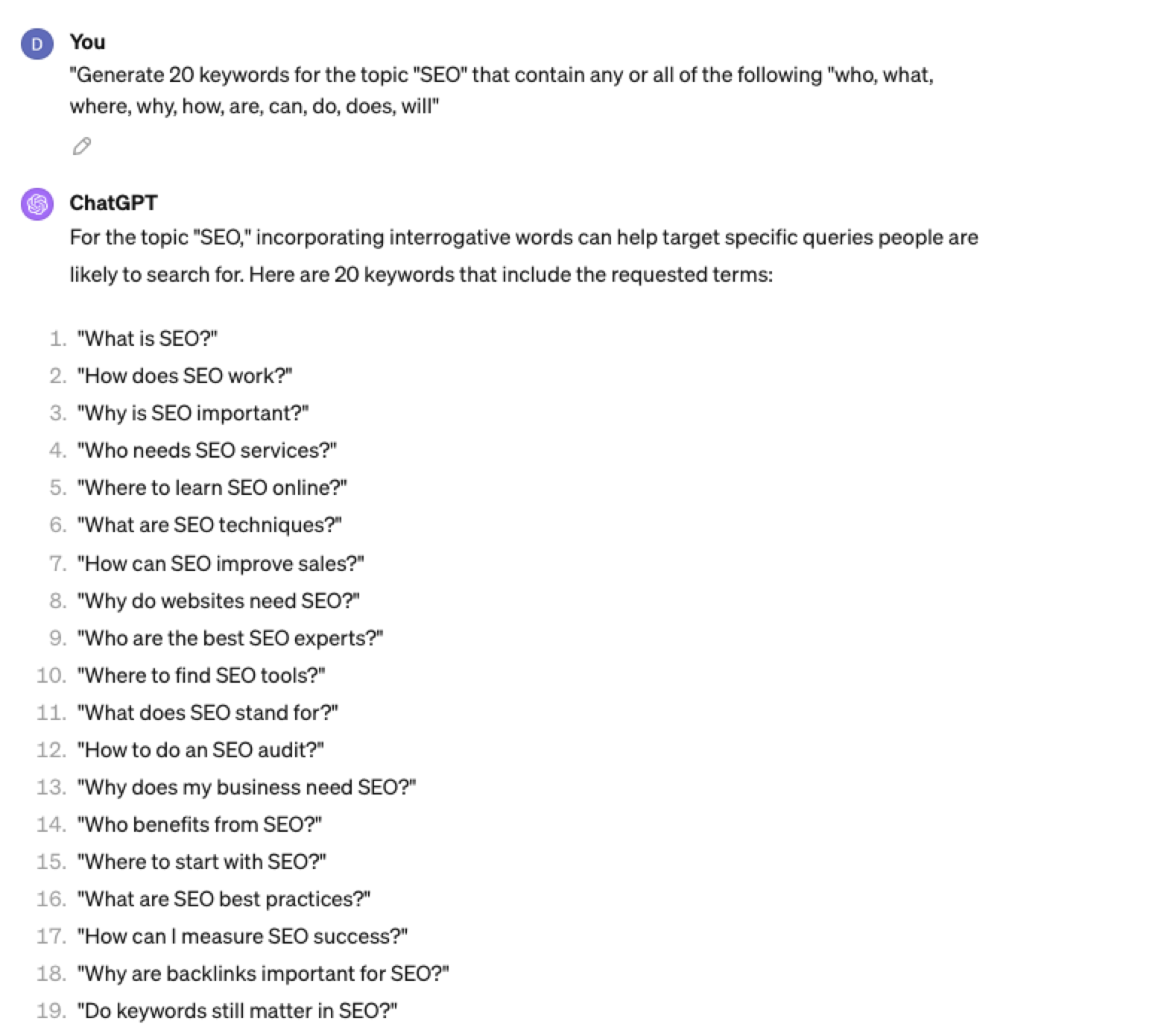 Screenshot ChatGPT 4, April 2024
Screenshot ChatGPT 4, April 20242. Comparison Patterns
Example:
“Generate 50 keywords for the topic “{Topic}” that contain any or all of the following “for, vs, alternative, best, top, review”
 Screenshot ChatGPT 4, April 2024
Screenshot ChatGPT 4, April 20243. Brand Patterns
Another one of my favorite modifiers is a keyword by brand.
We are probably all familiar with the most popular SEO brands; however, if you aren’t, you could ask your AI friend to do the heavy lifting.
Example prompt:
“For the top {Topic} brands what are the top “vs” keywords”
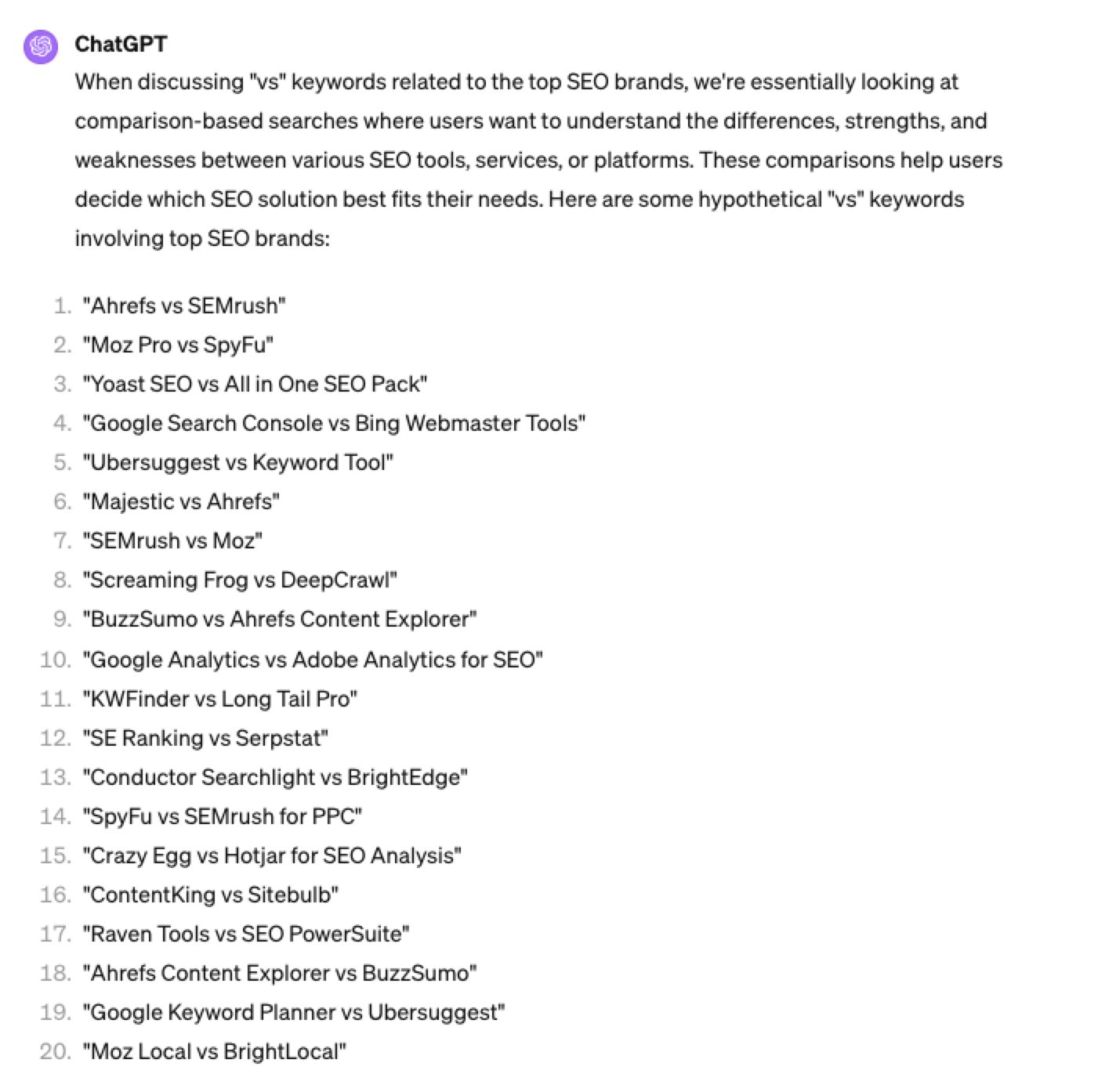 Screenshot ChatGPT 4, April 2024
Screenshot ChatGPT 4, April 20244. Search Intent Patterns
One of the most common search intent patterns is “best.”
When someone is searching for a “best {topic}” keyword, they are generally searching for a comprehensive list or guide that highlights the top options, products, or services within that specific topic, along with their features, benefits, and potential drawbacks, to make an informed decision.
Example:
“For the topic of “[Topic]” what are the 20 top keywords that include “best”
 Screenshot ChatGPT 4, April 2024
Screenshot ChatGPT 4, April 2024Again, this guide to keyword research using ChatGPT has emphasized the ease of generating keyword research ideas by utilizing ChatGPT throughout the process.
Keyword Research Using ChatGPT Vs. Keyword Research Tools
Free Vs. Paid Keyword Research Tools
Like keyword research tools, ChatGPT has free and paid options.
However, one of the most significant drawbacks of using ChatGPT for keyword research alone is the absence of SEO metrics to help you make smarter decisions.
To improve accuracy, you could take the results it gives you and verify them with your classic keyword research tool – or vice versa, as shown above, uploading accurate data into the tool and then prompting.
However, you must consider how long it takes to type and fine-tune your prompt to get your desired data versus using the filters within popular keyword research tools.
For example, if we use a popular keyword research tool using filters, you could have all of the “best” queries with all of their SEO metrics:
-
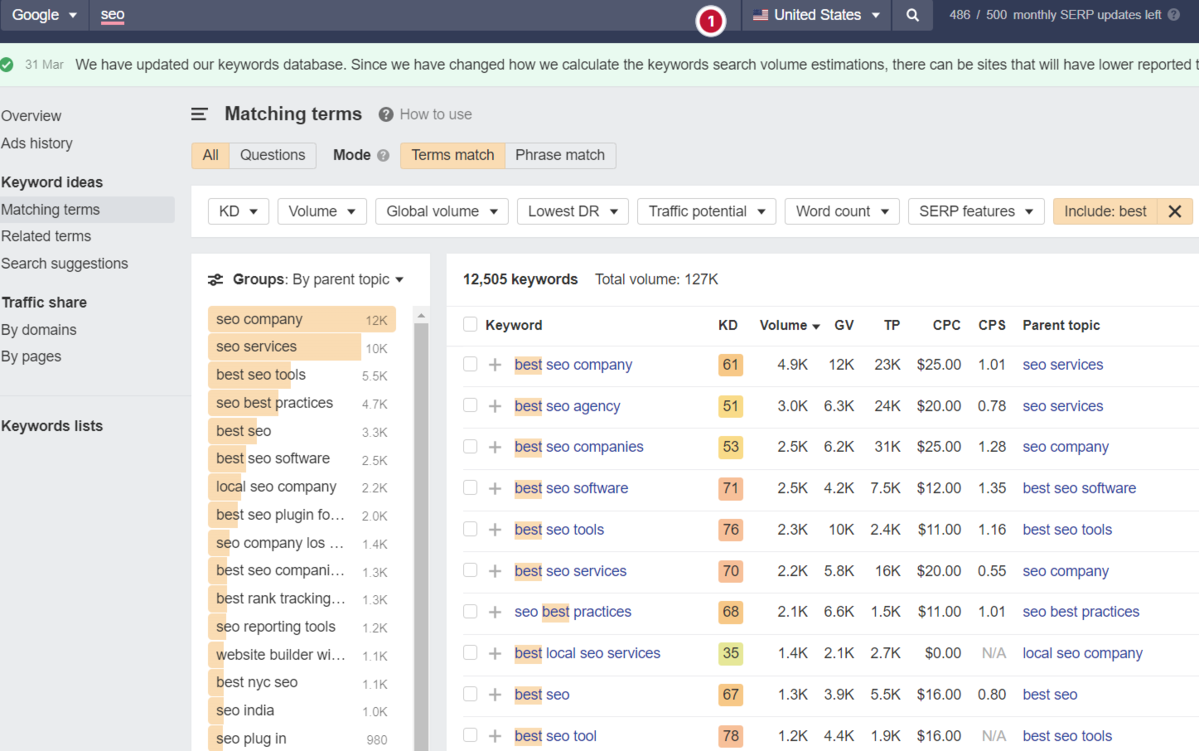 Screenshot from Ahrefs Keyword Explorer, March 2024
Screenshot from Ahrefs Keyword Explorer, March 2024
And unlike ChatGPT, generally, there is no token limit; you can extract several hundred, if not thousands, of keywords at a time.
As I have mentioned multiple times throughout this piece, you cannot blindly trust the data or SEO metrics it may attempt to provide you with.
The key is to validate the keyword research with a keyword research tool.
ChatGPT For International SEO Keyword Research
ChatGPT can be a terrific multilingual keyword research assistant.
For example, if you wanted to research keywords in a foreign language such as French. You could ask ChatGPT to translate your English keywords;
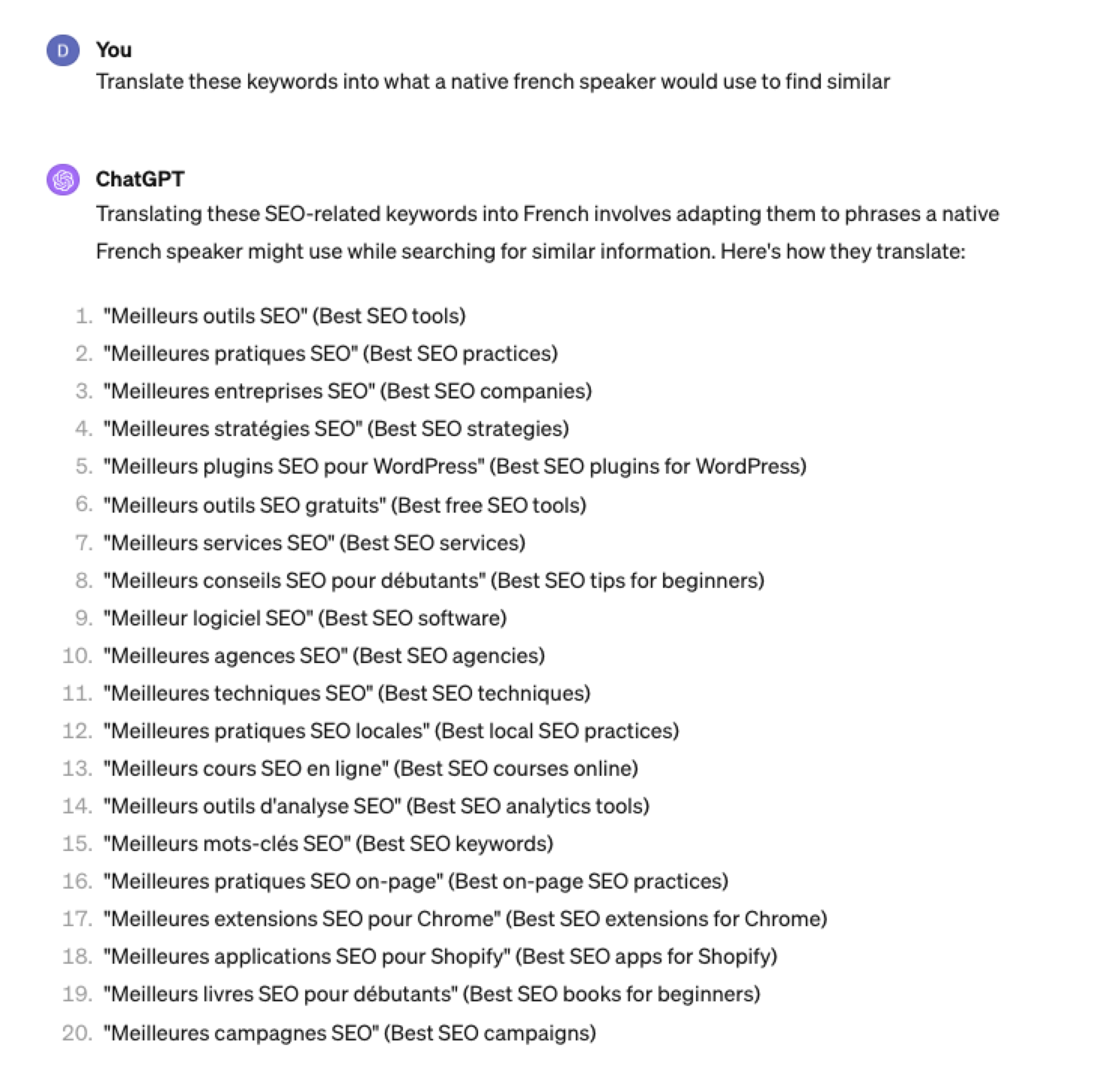 Screenshot ChatGPT 4, Apil 2024
Screenshot ChatGPT 4, Apil 2024- The key is to take the data above and paste it into a popular keyword research tool to verify.
- As you can see below, many of the keyword translations for the English keywords do not have any search volume for direct translations in French.
 Screenshot from Ahrefs Keyword Explorer, April 2024
Screenshot from Ahrefs Keyword Explorer, April 2024But don’t worry, there is a workaround: If you have access to a competitor keyword research tool, you can see what webpage is ranking for that query – and then identify the top keyword for that page based on the ChatGPT translated keywords that do have search volume.
-
-
 Screenshot from Ahrefs Keyword Explorer, April 2024
Screenshot from Ahrefs Keyword Explorer, April 2024
Or, if you don’t have access to a paid keyword research tool, you could always take the top-performing result, extract the page copy, and then ask ChatGPT what the primary keyword for the page is.
Key Takeaway
-
ChatGPT can be an expert on any topic and an invaluable keyword research tool. However, it is another tool to add to your toolbox when doing keyword research; it does not replace traditional keyword research tools.
As shown throughout this tutorial, from making up keywords at the beginning to inaccuracies around data and translations, ChatGPT can make mistakes when used for keyword research.
You cannot blindly trust the data you get back from ChatGPT.
However, it can offer a shortcut to understanding any topic for which you need to do keyword research and, as a result, save you countless hours.
But the key is how you prompt.
The prompts I shared with you above will help you understand a topic in minutes instead of hours and allow you to better seed keywords using keyword research tools.
It can even replace mundane keyword clustering tasks that you used to do with formulas in spreadsheets or generate ideas based on keywords you give it.
Paired with traditional keyword research tools, ChatGPT for keyword research can be a powerful tool in your arsenal.
More resources:
Featured Image: Tatiana Shepeleva/Shutterstock
SEO
OpenAI Expected to Integrate Real-Time Data In ChatGPT

Sam Altman, CEO of OpenAI, dispelled rumors that a new search engine would be announced on Monday, May 13. Recent deals have raised the expectation that OpenAI will announce the integration of real-time content from English, Spanish, and French publications into ChatGPT, complete with links to the original sources.
OpenAI Search Is Not Happening
Many competing search engines have tried and failed to challenge Google as the leading search engine. A new wave of hybrid generative AI search engines is currently trying to knock Google from the top spot with arguably very little success.
Sam Altman is on record saying that creating a search engine to compete against Google is not a viable approach. He suggested that technological disruption was the way to replace Google by changing the search paradigm altogether. The speculation that Altman is going to announce a me-too search engine on Monday never made sense given his recent history of dismissing the concept as a non-starter.
So perhaps it’s not a surprise that he recently ended the speculation by explicitly saying that he will not be announcing a search engine on Monday.
He tweeted:
“not gpt-5, not a search engine, but we’ve been hard at work on some new stuff we think people will love! feels like magic to me.”
“New Stuff” May Be Iterative Improvement
It’s quite likely that what’s going to be announced is iterative which means it improves ChatGPT but not replaces it. This fits into how Altman recently expressed his approach with ChatGPT.
He remarked:
“And it does kind of suck to ship a product that you’re embarrassed about, but it’s much better than the alternative. And in this case in particular, where I think we really owe it to society to deploy iteratively.
There could totally be things in the future that would change where we think iterative deployment isn’t such a good strategy, but it does feel like the current best approach that we have and I think we’ve gained a lot from from doing this and… hopefully the larger world has gained something too.”
Improving ChatGPT iteratively is Sam Altman’s preference and recent clues point to what those changes may be.
Recent Deals Contain Clues
OpenAI has been making deals with news media and User Generated Content publishers since December 2023. Mainstream media has reported these deals as being about licensing content for training large language models. But they overlooked a a key detail that we reported on last month which is that these deals give OpenAI access to real-time information that they stated will be used to give attribution to that real-time data in the form of links.
That means that ChatGPT users will gain the ability to access real-time news and to use that information creatively within ChatGPT.
Dotdash Meredith Deal
Dotdash Meredith (DDM) is the publisher of big brand publications such as Better Homes & Gardens, FOOD & WINE, InStyle, Investopedia, and People magazine. The deal that was announced goes way beyond using the content as training data. The deal is explicitly about surfacing the Dotdash Meredith content itself in ChatGPT.
The announcement stated:
“As part of the agreement, OpenAI will display content and links attributed to DDM in relevant ChatGPT responses. …This deal is a testament to the great work OpenAI is doing on both fronts to partner with creators and publishers and ensure a healthy Internet for the future.
Over 200 million Americans each month trust our content to help them make decisions, solve problems, find inspiration, and live fuller lives. This partnership delivers the best, most relevant content right to the heart of ChatGPT.”
A statement from OpenAI gives credibility to the speculation that OpenAI intends to directly show licensed third-party content as part of ChatGPT answers.
OpenAI explained:
“We’re thrilled to partner with Dotdash Meredith to bring its trusted brands to ChatGPT and to explore new approaches in advancing the publishing and marketing industries.”
Something that DDM also gets out of this deal is that OpenAI will enhance DDM’s in-house ad targeting in order show more tightly focused contextual advertising.
Le Monde And Prisa Media Deals
In March 2024 OpenAI announced a deal with two global media companies, Le Monde and Prisa Media. Le Monde is a French news publication and Prisa Media is a Spanish language multimedia company. The interesting aspects of these two deals is that it gives OpenAI access to real-time data in French and Spanish.
Prisa Media is a global Spanish language media company based in Madrid, Spain that is comprised of magazines, newspapers, podcasts, radio stations, and television networks. It’s reach extends from Spain to America. American media companies include publications in the United States, Argentina, Bolivia, Chile, Colombia, Costa Rica, Ecuador, Mexico, and Panama. That is a massive amount of real-time information in addition to a massive audience of millions.
OpenAI explicitly announced that the purpose of this deal was to bring this content directly to ChatGPT users.
The announcement explained:
“We are continually making improvements to ChatGPT and are supporting the essential role of the news industry in delivering real-time, authoritative information to users. …Our partnerships will enable ChatGPT users to engage with Le Monde and Prisa Media’s high-quality content on recent events in ChatGPT, and their content will also contribute to the training of our models.”
That deal is not just about training data. It’s about bringing current events data to ChatGPT users.
The announcement elaborated in more detail:
“…our goal is to enable ChatGPT users around the world to connect with the news in new ways that are interactive and insightful.”
As noted in our April 30th article that revealed that OpenAI will show links in ChatGPT, OpenAI intends to show third party content with links to that content.
OpenAI commented on the purpose of the Le Monde and Prisa Media partnership:
“Over the coming months, ChatGPT users will be able to interact with relevant news content from these publishers through select summaries with attribution and enhanced links to the original articles, giving users the ability to access additional information or related articles from their news sites.”
There are additional deals with other groups like The Financial Times which also stress that this deal will result in a new ChatGPT feature that will allow users to interact with real-time news and current events .
OpenAI’s Monday May 13 Announcement
There are many clues that the announcement on Monday will be that ChatGPT users will gain the ability to interact with content about current events. This fits into the terms of recent deals with news media organizations. There may be other features announced as well but this part is something that there are many clues pointing to.
Watch Altman’s interview at Stanford University
Featured Image by Shutterstock/photosince
-

 MARKETING7 days ago
MARKETING7 days agoA Recap of Everything Marketers & Advertisers Need to Know
-

 PPC5 days ago
PPC5 days agoHow the TikTok Algorithm Works in 2024 (+9 Ways to Go Viral)
-

 SEO6 days ago
SEO6 days agoBlog Post Checklist: Check All Prior to Hitting “Publish”
-

 SEO4 days ago
SEO4 days agoHow to Use Keywords for SEO: The Complete Beginner’s Guide
-

 MARKETING5 days ago
MARKETING5 days agoHow To Protect Your People and Brand
-

 SEARCHENGINES6 days ago
SEARCHENGINES6 days agoGoogle Started Enforcing The Site Reputation Abuse Policy
-

 PPC6 days ago
PPC6 days agoHow to Craft Compelling Google Ads for eCommerce
-

 MARKETING6 days ago
MARKETING6 days agoElevating Women in SEO for a More Inclusive Industry















You must be logged in to post a comment Login